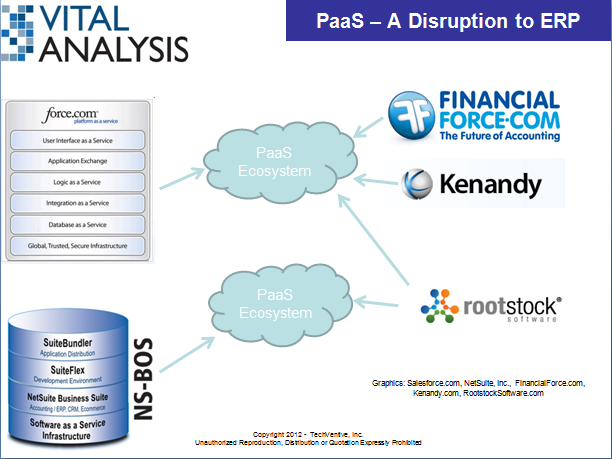State of ERP PaaS and PaaS ecosystems [part 2]

Part 2
State of ERP PaaS and PaaS ecosystems
SOA (service oriented architecture) has been a significant focus area of ERP and other application software vendors for the last decade or so. These architectures compartmentalized many common "services" such as user interface presentation, database access services, mobile device interaction, etc. By isolating specific services, large portions of code would remain unaffected by changes in one of the component service areas. SOA made application software easier to adjust to the evermore changing world full of cell phones, social networks, etc.
But, SOA was not necessarily designed for concepts such as multitenancy -- the critical capability found in the best software-as-a-service (SaaS) applications. Indeed, SOA was conceived in a time before distinctions such as single or multi-tenancy were commonplace. SOA was good but it did not possess the completeness, tools or ecosystem capabilities found in some of the PaaS environments of today.
The Force.com platform, for example, now contains development tools, cloud database technologies, code development tools and more. The VMForce offering possesses much more. It is an architecture that enables the citizen developer world where anyone with a live Internet connection and a computing device can build sophisticated Web applications on their own. That platform allows one, two or three person development teams (and larger) anywhere in the world the ability to build complex, powerful business applications. These programmers do not need to acquire expensive licenses for databases and other systems management tools. These programmers do not need to purchase computing hardware such as servers, routers and other devices. No, these developers need only an Internet connection to become commercial software firms.
It is the ease of use with which individuals can use platforms like force.com and iOS from Apple that both transforms the software industry and also the nature of the companies propelling these platform ecosystems. The size of the Apple iOS ecosystem is staggering when one sees the number of applications developed and the number of developers within the community. But more important is the fact that Apple has begun to build a separate marketplace for business applications created through this platform. Understand this, neither Apple, NetSuite, Salesforce.com nor are other vendors interested in just building a platform. No, they want to build an ecosystem and they want to do it badly.
So what's the big deal?
The big deal is the ecosystem - that's what's really BIG. It's not the applications a vendor has, it is the ecosystem around them. It is in the ecosystem where:
- hundreds of thousands of developers build extensions to the software vendor's applications
- other software firms build complementary, robust applications that run on the same platform as the vendor's applications
- users of the ecosystem can share their experiences, ratings and other feedback about the multitude of products available in the ecosystem
- channel partners flock to the ecosystem because they see a way to develop unique intellectual property and collect royalties on the usage of it thousands of times
- people, firms (large and small), partners and customers can monetize their intellectual property and product extensions
- providers of third-party data, analytical algorithms and other non-software types of intellectual property can find new users for their thoughtful works
The ecosystem is about money. A PaaS ecosystem extends the value opportunity by placing functionally rich, possibly low cost, vertically relevant extensions and new modules within the reach of all ecosystem users. Many of those extensions, modules, etc. come with price tags. The revenue from those solutions represents an income stream to their creators.
Let's not forget that the ecosystem has significant benefits to the vendor creating this environment. Apple, Amazon, salesforce.com, etc. are not creating these ecosystems and their technical environments for altruistic and non-economic reasons. They are collecting toll charges for usage, transaction fees and other events. These ecosystems make money for the provider. In some cases, they make the providers a lot of money. Next: The Ecosystem as a virtuous cycle and power unto itself
